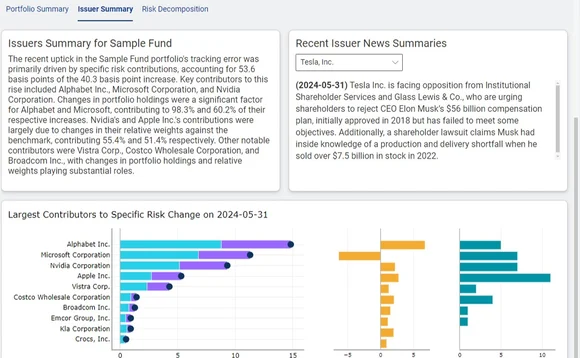The IMD Wrap: Will banks spend more on AI than on market data?
As spend on generative AI tools exceeds previous expectations, Max showcases one new tool harnessing AI to help risk and portfolio managers better understand data about their investments—while leaving them always in control of any resulting decisions.

The use of generative artificial intelligence across the capital markets and other industries and sectors is growing faster than analysts had expected, according to a report from 451 Research, which is part of S&P Global Market Intelligence. The acceleration in adoption prompted 451 Research to publish a “significant upward adjustment in market revenue predictions” for GenAI software spend, increasing its estimates for 2023 spend from $3.7 billion to $5.1 billion, and increasing its 2028 forecast from $36 billion to $52.2 billion.
At that rate, spend on AI software could soon overtake global expenditure on market data, which—according to research firm Burton-Taylor International Consulting—rose more than 12% in 2023 to a new record of $42 billion. Market data is generally acknowledged as a financial firm’s third—or in some cases, second—highest expense, behind personnel expenses and the cost of buildings and office space.
Now, I realize this isn’t an exact comparison: 451 Research’s analysis focuses on a range of sectors, while Burton-Taylor examines only financial firms’ data usage. But the shock value is genuine: This relatively new area of data and technology will soon overtake a long-established area of expense.
The role of the AI is not to do the thinking
Peter Shepard, MSCI
This may come as no surprise: The intense focus on GenAI over the past year or so, and the rush to find appropriate uses for it, has prompted a flurry of product developments and launches, especially among data providers seeking ways to make their data easier to understand, present, and use.
For example, University of Cambridge spin-out RegGenome last week unveiled a GenAI-powered regulatory data repository designed to help automate manual compliance workflows and to help applications identify what regulations might apply to them, and to find the relevant data to comply with the rules.
And while some practical uses of GenAI are clear-cut, others remain elusive and potentially off-limits for the long term, with results needing to be painstakingly scrutinized and validated before being used in any workflow that might itself be subject to regulation.
But the most obvious and immediately productive uses for GenAI are to make tasks like research quicker and easier by summarizing reports and correlating relevant information while still allowing humans—traders, portfolio managers, researchers, or risk professionals—to draw their own conclusions and make decisions.
One example of this is index and data provider MSCI’s AI Portfolio Insights, which the vendor will debut this week. It is designed to help risk managers and portfolio managers identify emerging risks that could impact their portfolios. Officials say AI Portfolio Insights—previously referred to by management as Analytics Insight—uses algorithms to curate large volumes of data, surface the most important factors affecting risk and performance, and then connect those to market events.
The tool is a web interface accessible via the MSCI One cloud-based technology platform that—with clients’ permission to get the most out of its features—is linked to clients’ portfolios, and provides a text summary of changes to factors affecting the portfolios, along with a text box that clients can use to ask it direct questions and receive answers.

“We’ve used AI internally across our organization for tasks like data quality, or to optimize workflows, but this is the first client-facing tool we’ve released that utilizes AI,” says Jorge Mina, head of analytics at MSCI.
From tradeoff to payoff
Clients can use the data to create reports and distribute those to analysts and research customers. But the AI tool is designed to deliver insights faster and more clearly, and to leave any decision-making to the humans in those roles.
“It’s descriptive in nature. We’re not trying to be predictive; we’re just showing what’s your risk today, how has it changed, and what are the contributors to those changes,” Mina says.
Peter Shepard, head of analytics research and product development at MSCI, makes a similar point that the vendor doesn’t allow the tool to overstep its boundaries.
“The role of the AI is not to do the thinking, because its financial reasoning is very limited. So the financial reasoning powering this is pretty much traditional financial modeling,” Shepard says. Just as a trading algorithm might generate a trade order, MSCI uses an algorithm to detect certain data, and the AI translates information from numbers into English-language text, and uses it to answer questions about the data.
But there’s a tradeoff. What helps deliver time savings and make data easier to understand and quicker for clients comes at a cost of time and resources for the vendor. In the case of AI Portfolio Insights, that time cost for MSCI was more than a year.
“We had a version one year ago that looked pretty good. And usually, with any new development, we go from ‘pretty good’ to ‘production good’ within a month. But we had a dedicated team working on that for the past year, getting it to be reliable,” Shepard says. “More than half of our work was around guardrails … so that the system knows what it can answer and what it can’t answer, so that it doesn’t come up with a ‘best guess’.”
That initial version was about 50% reliable, but MSCI needed the final product to be 95% or 100% reliable.
But the vendor anticipates that the tradeoff will deliver a payoff by allowing firms to share and surface information to different parts of their organizations more easily and efficiently, without needing to involve their technology teams. “This tool will enable our content—the risk and performance data and analytics we already provide to clients—to be consumed by a much broader audience,” Mina says.
The AI component can even adapt the writing style of responses, based on who that audience is, and what roles are consuming the results within an organization.
But wait, I hear you say, a year? To take something you’ve already built and make sure it works correctly? Isn’t AI supposed to solve all that and cut development times to next to nothing? Well, yes, in the long run. But before then, it’s going to be an intense and long slog to get to that point. And if anything, given AI’s tendency to hallucinate incorrect results, and the negative perception of many toward it, a slow and steady approach that is both cautious and explainable is the best approach.
Many people compare teaching an AI model to teaching a baby—there’s a long period of basically unproductive results before your child becomes more adept than you at programming the DVR. But once they do, they’ll be prolific, and you can spend more time watching your favorite shows than searching for them. Or, to translate that back into a finance setting, you can spend less time finding, checking, and interpreting data, and more time actually using it to get productive and profitable results.
Disagree with my opinion? Share yours! I’d love to hear about your experiences and experiments with AI. You can reach me at max.bowie@infopro-digital.com
Further reading
Only users who have a paid subscription or are part of a corporate subscription are able to print or copy content.
To access these options, along with all other subscription benefits, please contact info@waterstechnology.com or view our subscription options here: http://subscriptions.waterstechnology.com/subscribe
You are currently unable to print this content. Please contact info@waterstechnology.com to find out more.
You are currently unable to copy this content. Please contact info@waterstechnology.com to find out more.
Copyright Infopro Digital Limited. All rights reserved.
As outlined in our terms and conditions, https://www.infopro-digital.com/terms-and-conditions/subscriptions/ (point 2.4), printing is limited to a single copy.
If you would like to purchase additional rights please email info@waterstechnology.com
Copyright Infopro Digital Limited. All rights reserved.
You may share this content using our article tools. As outlined in our terms and conditions, https://www.infopro-digital.com/terms-and-conditions/subscriptions/ (clause 2.4), an Authorised User may only make one copy of the materials for their own personal use. You must also comply with the restrictions in clause 2.5.
If you would like to purchase additional rights please email info@waterstechnology.com
More on Data Management
New working group to create open framework for managing rising market data costs
Substantive Research is putting together a working group of market data-consuming firms with the aim of crafting quantitative metrics for market data cost avoidance.
Off-channel messaging (and regulators) still a massive headache for banks
Waters Wrap: Anthony wonders why US regulators are waging a war using fines, while European regulators have chosen a less draconian path.
Back to basics: Data management woes continue for the buy side
Data management platform Fencore helps investment managers resolve symptoms of not having a central data layer.
‘Feature, not a bug’: Bloomberg makes the case for Figi
Bloomberg created the Figi identifier, but ceded all its rights to the Object Management Group 10 years ago. Here, Bloomberg’s Richard Robinson and Steve Meizanis write to dispel what they believe to be misconceptions about Figi and the FDTA.
SS&C builds data mesh to unite acquired platforms
The vendor is using GenAI and APIs as part of the ongoing project.
Aussie asset managers struggle to meet ‘bank-like’ collateral, margin obligations
New margin and collateral requirements imposed by UMR and its regulator, Apra, are forcing buy-side firms to find tools to help.
Where have all the exchange platform providers gone?
The IMD Wrap: Running an exchange is a profitable business. The margins on market data sales alone can be staggering. And since every exchange needs a reliable and efficient exchange technology stack, Max asks why more vendors aren’t diving into this space.
Reading the bones: Citi, BNY, Morgan Stanley invest in AI, alt data, & private markets
Investment arms at large US banks are taken with emerging technologies such as generative AI, alternative and unstructured data, and private markets as they look to partner with, acquire, and invest in leading startups.








